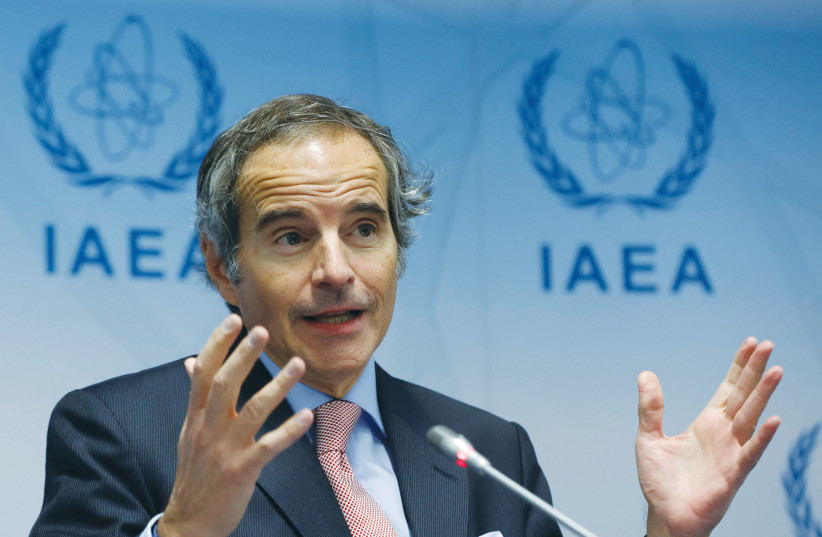Don’t be fooled by Iran-IAEA games, time running out to block nukes
Iran’s response to the International Atomic Energy Agency’s (IAEA) condemnation on June 5 was surprisingly muted.Since 2012, the IAEA has had the guts to condemn the Islamic Republic for its numerous nuclear violations only four times, so the retaliation could have been fierce and significant.
Instead, Tehran “merely” disclosed to the IAEA and various diplomats that it was going to increase the number of centrifuges it uses to enrich uranium, including to the 60% level.
In 2020, such a change would have been an earthquake-like elevation of the potential nuclear threat level.But the fact is that Iran has now been enriching to the 60% level with very large numbers of advanced centrifuges for four years without crossing the nuclear weapons threshold.
So, as dangerously close to nuclear weapons as this brings Tehran, it is far short of jumping to the 90% weaponized uranium level, withdrawing from the Treaty on the Non-Proliferation of Nuclear Weapons, and kicking out not just some but all of the IAEA nuclear inspectors from the country.

Even if part of Iran’s weak retaliation is due to being in a presidential transition period until June 28, when a new president will replace Ebrahim Raisi, who died recently in a helicopter crash, the fact is that the response was weak.
In that sense, the West could be ready to pat itself on the back: for the first time in 18 months, it condemned Iran’s nuclear violations, and the Islamic Republic itself seemed deterred from doing much about it.But this misses the real story.
The real story is that the West – and Israel, for that matter – are working on borrowed time against Supreme Leader Ayatollah Ali Khamenei’s nuclear program.
Limitations are beginning to expire
As of October 2025, the limits on Iran’s number of centrifuges from the 2015 nuclear deal start to expire.As of January 2026, the nuclear deal’s ultimate weapon to keep Khamenei in line – the “snapback” of UN global sanctions, which China and Russia cannot veto – expires.
From now until late 2025 or early 2026, the ability of the West to threaten Iran with that snapback and try to “box” Tehran back into the nuclear deal’s limits could still be meaningful.
Perhaps Russia and China would choose to ignore the sanctions, but many other countries that are doing business with China would follow them, and even Moscow and Beijing would have to think about the issue carefully (a decade ago, they did observe the sanctions).
The IAEA’s condemnation is a prime opportunity to refer the issue to the UN Security Council and to give Khamenei an ultimatum: if he does not freeze and walk back his nuclear progress by a certain date, he will face a snapback.
Additionally, returning to the nuclear deal could still be significant until late 2025, despite its imperfections, as the nuclear limits would not have expired and could serve as leverage to extend them.
So, while the IAEA’s condemnation was no less than a zero pushback on the Islamic Republic, without the UNSC snapback threat sometime in the next year, it is grossly insufficient to stop Khamenei.
OF COURSE, even the snapback of global sanctions, which brought Iran to its knees in 2015 and led it to give away the equivalent of enough material for 10 nuclear bombs, might not work as a threat in 2024-2025.
In that case, Israel and the West need to get more serious about a viable military option to deter Khamenei from crossing the threshold and get him to backtrack to a point where detecting a nuclear “breakout” would be easier than it is now. If Tehran chooses to weaponize its uranium, it is currently back to having enough enriched material for between several and more than 10 potential nuclear weapons.
Here, too, Israel and the West are operating on borrowed time.
Since 2022, Iran has been working on a new nuclear facility under a mountain near its existing Natanz nuclear facility.
The idea for this facility is to be even deeper underground than the Fordow nuclear facility, which is 80–90 meters underground.
The purpose of building deeper than Fordow would be to get so far underground that even the much-vaunted and sought-after American “bunker buster” bombs might be unable to destroy the facilities.
Although Iran had originally hoped to complete these facilities in 2023-2024, the more likely updated completion schedule is sometime in 2025.
This means that the West’s and Israel’s “viable” military threat may only remain viable until sometime in 2025, when this facility goes operational.
Putting all the puzzle pieces together, it appears that by late 2025 to January 2026, the clock might run out on both the global sanctions snapback threat and the viable military threat.
In other words, the West and Israel may lose their few remaining tools to deter Khamenei from obtaining nuclear weapons, and at the rate that the Islamic Republic is enriching uranium, this could mean not one bomb but an arsenal.
This would be consistent with the Mossad’s findings in 2018, after seizing Iran’s secret nuclear archives, that Khamenei sought to develop five nuclear weapons.
While the West and Israel are distracted by Gaza, the time may almost be up to address the much greater threat to regional and world peace and security.





Comments are closed.